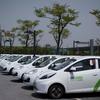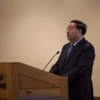Economy and Policy
2019
Mar
07
. 2019. “Carbon taxes and the double dividend hypothesis in a recursive-dynamic CGE model for SpainAdd PublicationLinks.” Economic Systems Research.
. 2019. “Entering and exiting: Productivity evolution of energy supply in China.” Sustainability, 11, 983. Publisher's VersionAbstract
. 2018. “Industrial Water Pollution Discharge Taxes in China: A Multi-Sector Dynamic Analysis.” Water, 10, 12, Pp. 1742. Publisher's VersionAbstract
哈佛中国项目组织本科生暑期赴中国参与环境问题研究
评论:其实4也可以是个幸运数字?中国人对数字4的忌讳心理居然可以用来研究北京空气污染对健康的影响
. 2018. “Power system capacity expansion under higher penetration of renewables considering flexibility constraints and low carbon policies.” IEEE Transactions on Power Systems, 33, 6, Pp. 6240-6253. Publisher's VersionAbstract
《金融时报》报道中国项目关于电动汽车充电方式对中国环境影响的最新研究
评论:全球电网是否是通向低碳未来之路?
中国国家电网公司前董事长刘振亚就全球能源互联网在哈佛大学发表公开演讲
2018
Apr
27
. 2018. “Environmental fiscal reform and the double dividend: evidence from a dynamic general equilibrium model.” Sustainability, 10, 2. Publisher's VersionAbstract
. 2018. “Non-CO2 greenhouse gas emissions in China 2012: Inventory and supply chain analysis.” Earth's Future, 6, 1. Publisher's VersionAbstract
2018
Apr
25
2018
Apr
17






